This post is also available in:  Deutsch (German)
Deutsch (German)
Are you planning your next holiday in Namibia and would like to take a dog with you?
We travel regularly with our dog from Germany to Namibia. Every time our Penny enriches our holidays. If you are thinking about taking your dog with you on holiday to Namibia, we will give you all the information you need here.
There are three major sections in this blog post:
- First, you need to think about whether you really want to take your dog.
- If you choose to do so, some formalities need to be completed.
- Finally, we describe a typical flight with a dog.
Our Penny
In May 2006 Penny came into our lives. In the weeks earlier, we had thought a lot about our future dog, because one thing was certain: We like to travel, and when we acquire a dog, we want to take it with us on holiday – even if we are going to Namibia.
A little bit of research on the Internet revealed
- Yes, we can enter Namibia with a dog – also at Hosea Kutako International Airport.
- But not every airline allows you to take an animal with you.
- If the dog is to travel in the cabin of an aircraft, it may not weigh more than six kilograms. If the dog is heavier than that, it must travel to the cargo area of the aircraft.
- Before we enter Namibia with the dog, we have to complete some formalities.
- There are also EU formalities for bringing the dog back to Europe.
- Many people are critical about taking an animal to Africa. Often this criticism is quite justified.
We had already heard some horror stories about animals in the cargo area of an aeroplane, for example when it had been forgotten to turn on the heating. Therefore, it was clear to us from the beginning: if we get a dog, then we get one that we can take into the cabin of the plane. So only small breeds remained for consideration and of those we liked Jack Russell-Terrier the most.
After all these considerations, we one Sunday held an eight-week-old Jack Russell Terrier girl in our hands. We christened her “Penduka”, which translated from the Herero means “wake up!”. However, from the beginning, she was only called “Penny.” But she also understands that terms like “princess” or “stinky” apply to her.
Our Penny has grown into a professional traveller. Whether in the car, train, plane, ship, bicycle or motorcycle – the most important thing (for her) is that she can be with us. From Cornwall to Estonia to Italy she has seen many other parts of Europe. And of course, she has been on many trips in Namibia and South Africa.
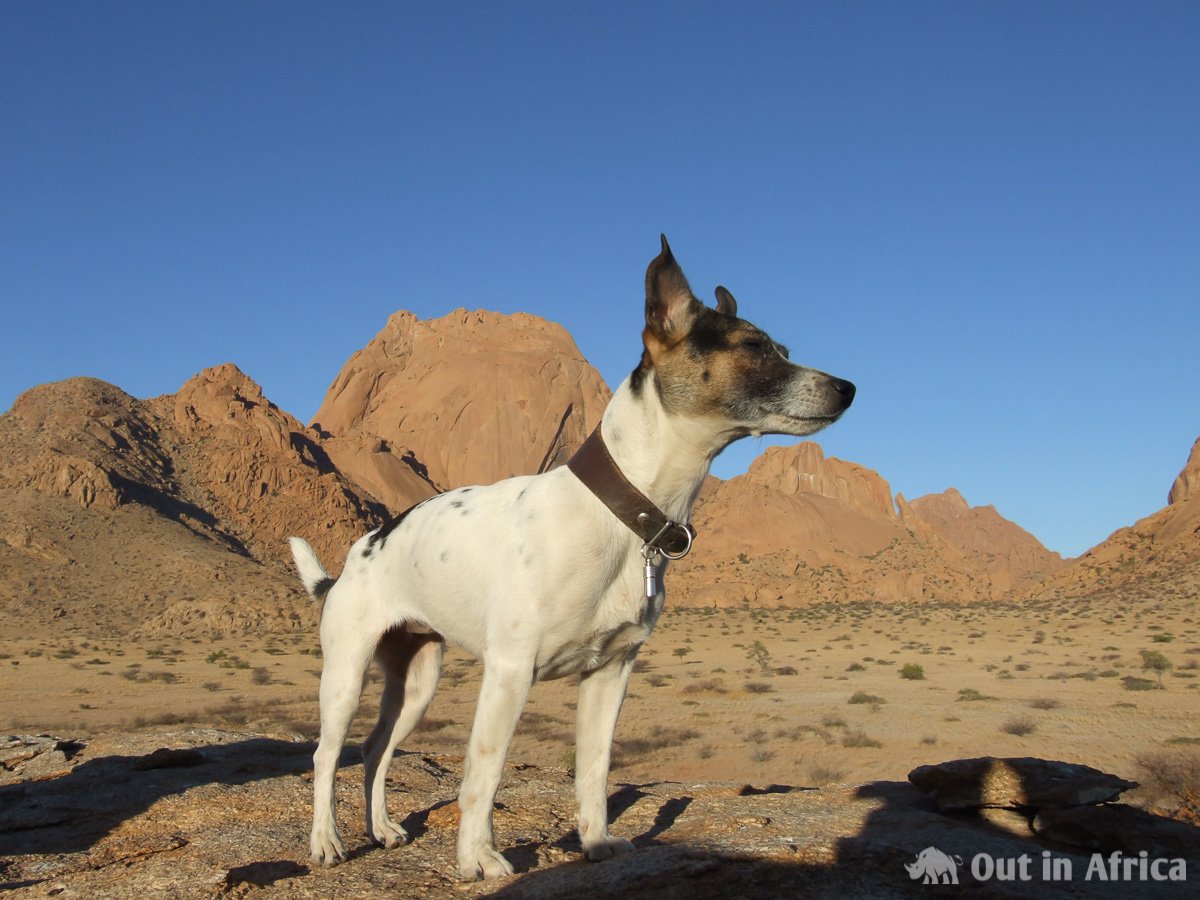
Pros and cons
Important considerations before the trip
A journey with a dog from Europe to Namibia needs to be well considered. That’s why we’re listing here the arguments in favour and against a trip with a dog.
Pros
Why take a dog on holiday to Namibia?
The fact that we take our dog to Namibia caused a lot of people to shake their heads. But before I go into the limitations and criticisms, I would like to explain why we always have Penny with us whenever we can.
First of all, she’s part of our little family. When you get a dog, you get a new family member, and the dog gets – from its perspective – a pack. This structure is very important for the dog and us. For Penny, her pack – us – is the most important thing after food. She can stay alone for a few hours, but a separation for several days and weeks is difficult for all of us.
Secondly, it is fun to go on holiday with a dog. Penny enjoys it to the fullest, and we are happy when she is there.
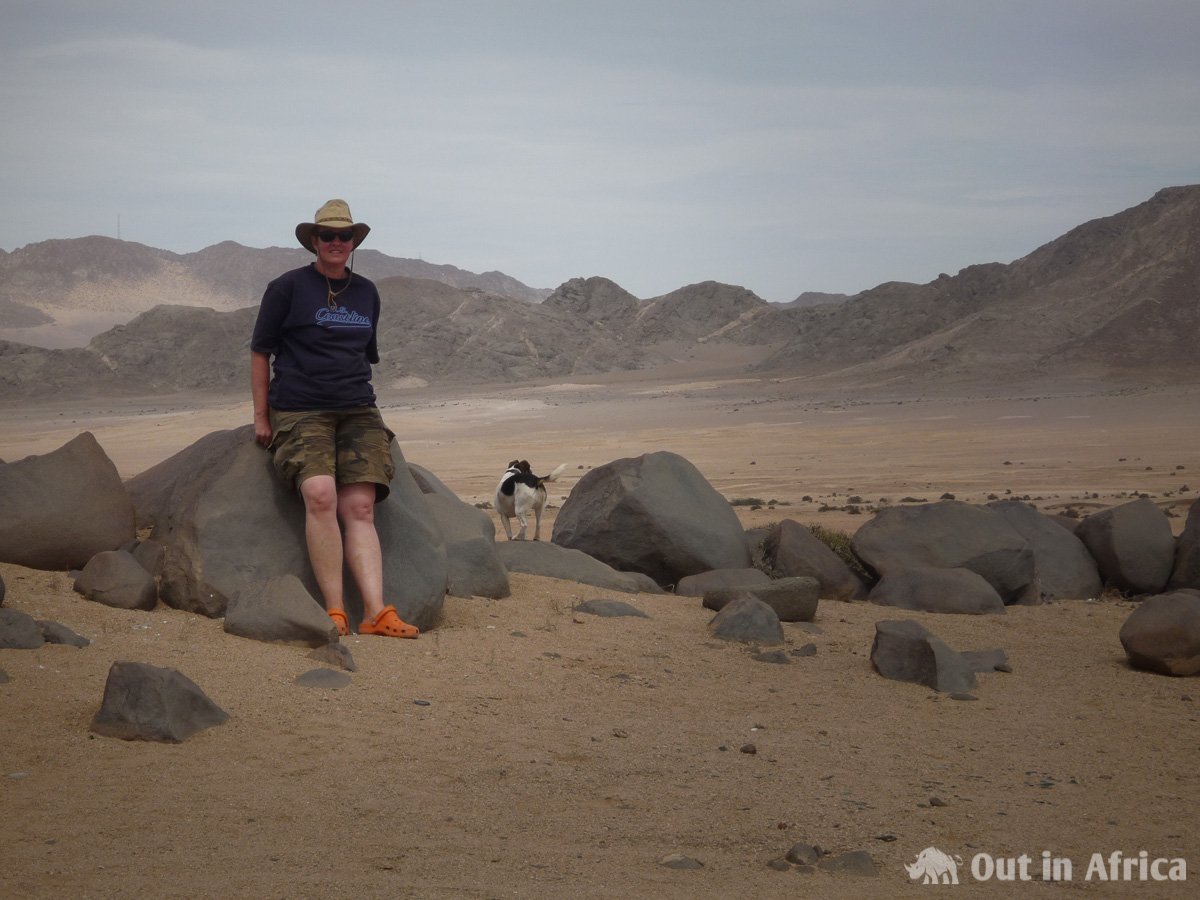
Thirdly, a dog offers protection. Even a small dog like Penny can keep strangers at a distance and warn of dangerous animals. One evening we were sitting outside in front of our tent when Penny started growling. Anita lit up the campsite with her flashlight and saw a spitting cobra winding past our table and climbing into a tree. If Penny hadn’t growled, something bad could have happened. Another time we were woken up by barking dogs in the morning when a hyena visited our campsite. We also believe that the car’s contents are better protected when the dog is inside than without it – even if the windows are slightly open for air to enter.
Namibia is not a dog-hostile country. Most families have at least one, if not a more than one, dog.
Cons
Why wouldn’t you take your dog with you?
I have already said that there were also concerns and criticisms about taking Penny along. Some points are justified, others are not.
The long journey
A direct flight between Germany and Namibia takes at least 10 hours. Also, there is time before for the security check and afterwards for immigration and customs. Can a dog endure this that long?
Yes, it can. How exactly will I describe later in this blog post. In short: A dog can be on a trip by plane for 12 hours, but it should not last much longer. At the moment (2018/2019) you can take a dog into the cabin with two airlines flying to Namibia: Condor and KLM. But Condor doesn’t fly in the European winter. So, if you want to fly with your dog between October and April, only KLM is left. But KLM is making a stopover in Angola. The flight time is prolonged by at least one hour, and that is close to the limit of what we can expect from our dog. That is why we only fly with the Condor at the moment, and therefore we are not quite so free as far as the period in which we can travel is concerned.
Air Namibia also takes dogs with it in the cargo area. Unfortunately, animals are not allowed in the cabin. If you choose this airline, the flight takes 10 hours, but the animal must be checked in with your luggage. The time in the cargo box is extended by at least two hours.
Since we only take Penny in the cabin, I won’t go into the matter of taking a dog with you in the cargo. You can keep it in mind, though. We have often met tourists who have taken their shepherd dogs or Labradors with them.
Here’s what you need to ask yourself:
- Can your dog lie still for 10 hours without using sedatives?
- Is it not afraid of flying?
- Can you expect it to stay in a small space for that long?
- Can it feel comfortable in a flight bag?
- Can you handle the lack of space for 10 hours?
Only if you can answer all these questions with “Yes” should you consider taking your dog with you.
If you have answered one or more questions with “I don’t know”, you may want to take a shorter trip with the dog beforehand and test if both the dog and you can handle it.
And if you answered “No” to one or more questions, leave your dog at home.
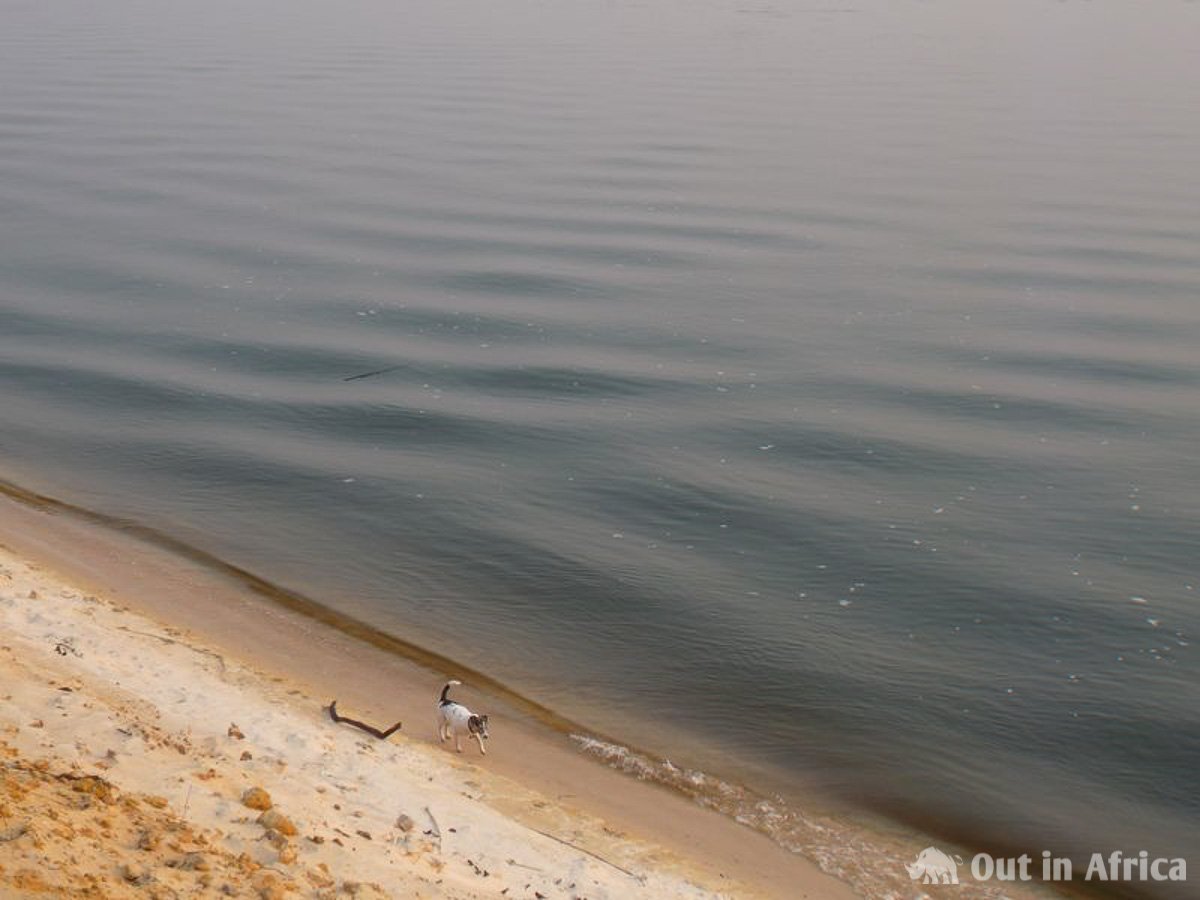
It is not always possible
There were a few years in which no airline that allowed a dog in the cabin flew to Namibia. In the cargo section, it would always have been possible, but we didn’t want to do that. That’s why Penny had to stay with dear friends in Germany. We missed her terribly during our vacation and were very happy when the Condor announced to fly to Namibia.
So, don’t expect that you can always take your dog with you and have a holiday home ready for him or her. We had neighbours in the village who took care of her.
Formalities
You can’t just show up at the border control in Namibia with a dog and think that the dog is waved through. No: one must show the appropriate stamped permits and afterwards visit the veterinary office in Windhoek. The veterinary office in Windhoek is one of the more efficient authorities in Namibia, but for the procurement of the forms, it is almost imperative that you have a contact person on the spot who gets the forms and sends them to Europe.
Theoretically, the Namibian Embassy in Berlin is also a way to go, but in our experience, the Embassy did not help us. We paid for the required form, but unfortunately, it never arrived.
One of the formalities is that you have to visit an official veterinarian in Germany.
Expenses
Before the dog is allowed on the plane, the owner must present a ticket for the animal. The cost is half the cost of a human, but the dog does not get a seat. It must be pushed under the front seat like hand luggage.
Also, there are vaccinations and medication. The vaccinations, which a dog must have for Namibia, it also needs in Germany. But we always take a spot-on against ticks and other insects with us. Also, the dog needs medication against heartworm when travelling to the north of Namibia.
You can’t neglect the costs for the entry and exit formalities. For the entry permit, you have to pay an amount of 150 NAD in Windhoek. Furthermore, the official veterinarian in Germany must examine the dog and fill out a form. That is also an expense.
Other expenses include a bag that complies with IATA specifications. We needed this bag for the other trips anyway, so we don’t consider it an extra cost. We have been using a Hunters flight bag for many years. If the dog travels in the cargo area, it needs an appropriate box made of hard plastic.
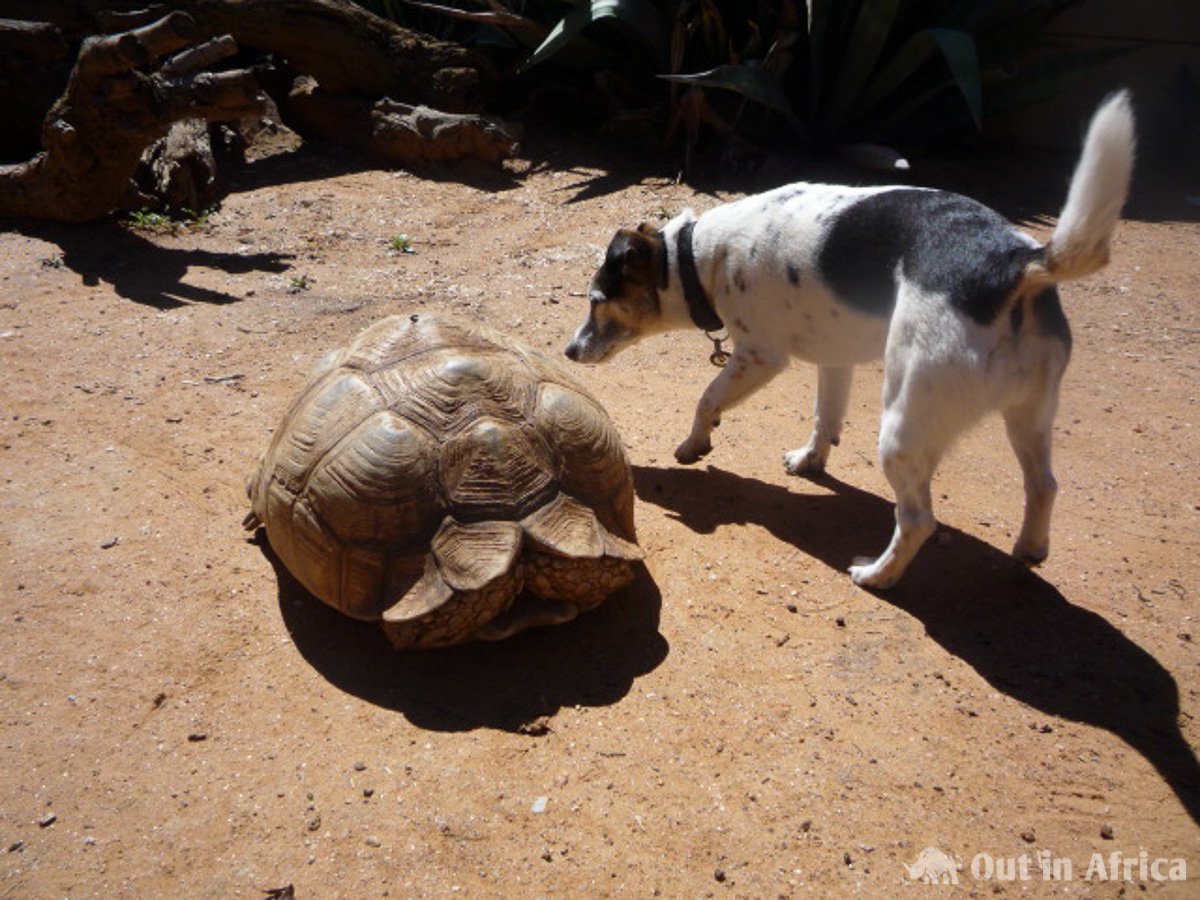
Constraints
If you are going on a guided tour, you should ask in advance if dogs can be taken along. But even as a self-driver you should keep in mind:
You can’t go everywhere with a dog. Pets are not allowed in the national parks, and you should not smuggle your animal into them. If discovered, it could be killed immediately. Now one might say that the rangers sometimes have dogs and that assistance dogs are allowed. But these animals get extra vaccinations and are an exception. This exception is never made for normal pets.
Destinations like Etosha, Sossusvlei and Fish River Canyon are not accessible with dogs. But that doesn’t mean that you can’t see or experience anything anymore. We had visited these destinations several times before Penny came into our lives and are planning to go back to them when she is no longer with us. As long as she’s around, we’ve got alternative destinations to go to. There are many places still on our bucket list.
However, if this is your first trip to Namibia, you should really consider whether you want to skip these destinations and many more.
Also, not all lodges or campsites allow animals. The first question we always ask when planning our accommodation is: is the campsite “pet-friendly”. Our experience is that dogs can usually come with us, even when it is not allowed. The only important thing is that you clean up after your dog and make sure that it doesn’t steal food from other campers.
Almost all shopping malls forbid animals. Since you cannot leave the animal in the car when it is in the sun, there are only two possibilities: you park in a parking garage, or someone stays in the car so that the windows can remain open.
Even if you visit the authorities, it is difficult to take a dog with you.
For those of you who want to rent a car, it is also necessary to ask the rental company beforehand whether it is okay to take a pet with you. We own a car and are therefore not restricted.
Dangers for the dog
Sometimes you might think that people think Namibia is a Mars colony, at least a hostile habitat for dogs. The fact is that Namibia is on earth and that there are also many local dogs that feel as comfortable there as their European counterparts do here.
We often hear “It’s too hot” or “It’s too dangerous”.
Before our first trip with Penny, we had many considerations. We wanted to go in December and knew it would be very hot. And: how would she cope with the thorns? The reality was Penny tolerated the heat without any problems. From day one it was as if she had always lived in Namibia.
When we go for a walk in the Veld, it happens that she steps into thorns. Then we also carry her for short distances and are glad that we have a small dog.
And there are snakes and scorpions. Penny is a Jack Russell terrier and therefore naturally curious and equipped with a hunting instinct. But so far, she has never had an unpleasant encounter with a dangerous animal. Yes, we’ve dealt with spitting cobras, scorpions and black mambas while she was around, but we took care, and our dog was never in danger.
It doesn’t have to be a crawling animal. Baboons, hyenas or big cats can also be fatal.
Therefore, you have to think on behalf of the dog and be especially attentive.
And yes, you have to expect the dog to die. But this is also the case in Europe, where the main source of danger is road traffic.
It is sad, but dogs are also stolen in Namibia. And unfortunately, they sometimes end up in the saucepan or on the barbecue grill. As a tourist, it is more difficult than for a local to find the dog again.
A different dog culture
While it is normal in Germany and other European countries to walk your dog, this is rather unusual in Namibia. There, most people live in houses with large properties. The dog can run around freely and does his “business” there, which then has to be cleared away.
Dogs in Namibia spend a lot of time outdoors, on the property. This means that if you go down a street in a residential area with (or without) a dog, you will be barked at from every yard. Dogs are protection in Namibia even more than in Europe. Their owners want the dog to bark when someone walks past the property. It’s annoying for the walker.
Nevertheless, in cities like Windhoek, Swakopmund or Walvis Bay there are places where you can go for a walk with your dog. But that also means that if you want to go out with the dog, you have to go to these places first, if you don’t live in the neighbourhood right away. That’s cumbersome.
Yes, you can go for a walk with the dog on a leash elsewhere. Only it is unusual and attracts curious glances.
Our special circumstances
But we also have to say that unlike many tourists, we have a “home” with our family in Namibia. There is a large fenced yard, and many other pets are living there. Having this home base makes many things much easier, at least for the days we spend in Windhoek. Penny is part of the family there, and there’s always someone who takes care of the dog when we have to go into town and can’t or won’t take her with us.
Besides, we’re not “normal” tourists. Yes, we always travel, but our destinations are not always the usual tourist destinations. We also like to visit family or friends on the farm. We can easily take Penny with us.
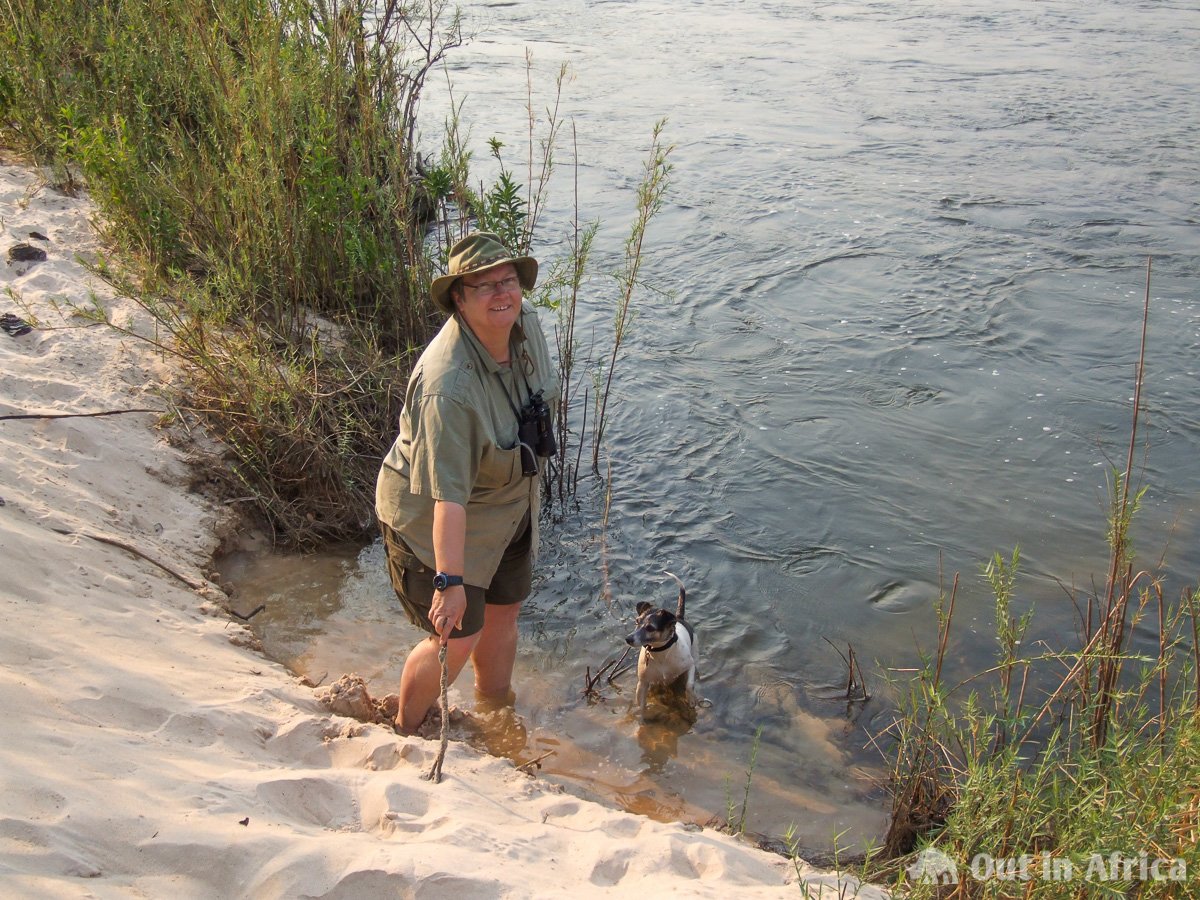
Preparation
If you still want to take your dog with you to Namibia, there are some things to do before you leave.
You probably want to bring the dog back to Europe. In this case, too, some formalities must be observed.
Vaccinations
Rabies vaccination is compulsory. When the dog is brought back to Europe, the rabies titre must be correct, i.e. the blood test for the rabies antibodies must be available.
We have Penny regularly vaccinated against everything possible. We do not only do this for the journeys but first of all, so that the dog, also in Europe, remains as healthy as possible.
During the first trip we wanted to make with Penny to Namibia, the rabies titre was not correct. We had to leave her in Germany. On the next trip, everything was fine, and Penny came along.
Our veterinarian recommends that we take tablets against heartworm if we want to travel to the north of Namibia. A vaccination that is not necessary for Namibia is against African sleeping sickness. One should do without it because the treatment is dangerous for the animal.
Chip
A chip is not a requirement for the import of the dog to Namibia, but to travel back to Europe.
European pet passport
This booklet is not a prerequisite for entering Namibia, but for returning to Europe. All vaccinations are recorded in the booklet.
However, we have had the experience that the pet passport impressed the authorities in Namibia and South Africa very much. It is important that a “passport photo” of the dog is pasted into the passport. It makes it particularly easy to obtain import permits and to deal with border officials. “A passport for the dog! With a photo!” they exclaimed excitedly to us.
Flight Booking
When applying for an import permit, you must state when, where and how the animal will enter Namibia. Therefore, you have to have booked your ticket and that for the dog already.
Import Permit
The Namibian Veterinary Office issues the import permit. This step is easiest if you have someone in Namibia who goes to the veterinary office to fill in the appropriate forms and then picks up the permit. Alternatively, you can contact the Namibian Embassy in your country.
Application for import permit
First, you apply for the “Veterinary import permit for Animals / Animal Products into Namibia”. Here you can find an example of the application.
The form must be filled in and handed in at the veterinary office in Namibia together with 50 N$ or 16 € at the embassy.
We once tried it through the embassy in Berlin, but never got any feedback. Since then, we have been asking family or friends in Namibia to go to the veterinary office for us.
It is not necessary that the owner of the dog fills in the form. Any person claiming to be the importer can do so. The veterinary office in Namibia doesn’t care who is the owner of the dog.
Veterinary Permit for the Import of Dogs
A few days later your contact person in Windhoek or you will get the “Veterinary Permit for the Import of Dogs (no quarantine)” (see PermitFuerHund.pdf).
As we go the direct way via Windhoek, the permit still has to be sent to Germany. Fortunately, we always find someone who takes the letter to Germany and sends it to us. Before that our contact person scans the form and sends it by email. This serves as a backup in case the paper is lost.
The name of the person importing the animal and the address in Namibia are shown.
However, the import of the dog is only allowed under certain conditions, the most important of which is condition 2: a veterinarian of the German veterinary office must fill out, sign and stamp the attached form.
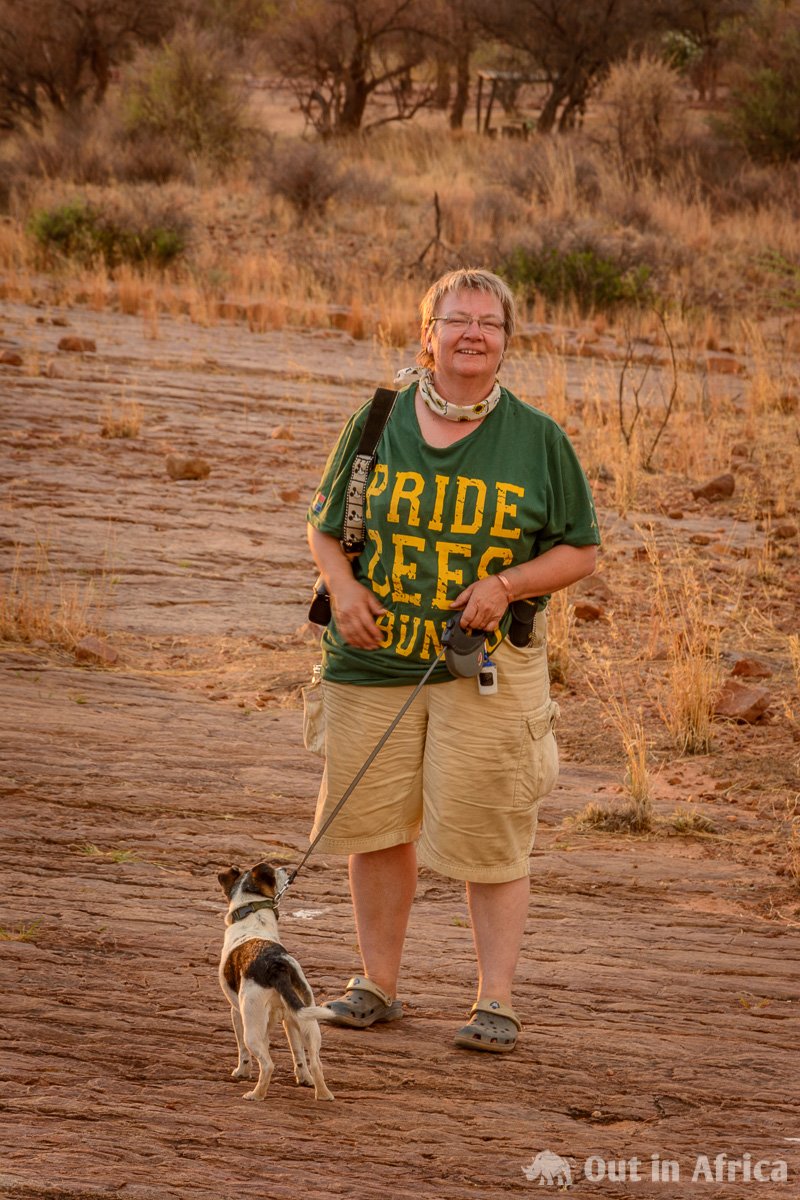
Official veterinarian in Germany
No longer than three days before the journey a German official veterinarian must examine the dog.
There can be two hurdles here:
First, the form the vet has to fill in is in English. Not all German veterinarians speak English so well that they want to fill in the form. It has proved to be a good idea to take along a German translation of the for. Here you can download a translation.
Secondly, on the penultimate and last page of the form, there is a list of diseases for which the veterinarian must certify that the country of origin is free of these diseases or that laboratory tests are available to show that the animal is not infected with these diseases.

In some districts, veterinarians are sticking to the fact that the disease could theoretically exist (even if no animal is known to be affected). In our district, the veterinarian always certifies that the country is free of the diseases.

If the veterinarian does not do this, he wants to see the blood tests listed on the last page. It is best to ask your official veterinarian a few months in advance how he will answer this If needed, you will not have to do the appropriate tests more than 30 days before departure and present them to the veterinarian.

The stamps of the official veterinarian are very important on the form. The more, the better.
On the form, there is a fax number. This number does not function – a veterinarian at the veterinary office in Windhoek confirmed this to us. We digitise the completed form and send it by email and usually get an error message.

Gear
Before departure, you should also get all the equipment you will need during your flight and your stay in Namibia. For us, that means:
Medications
Penny has a heart disease that requires her to take tablets daily. We pack enough of these. We also obtain spot-on against ticks and fleas.
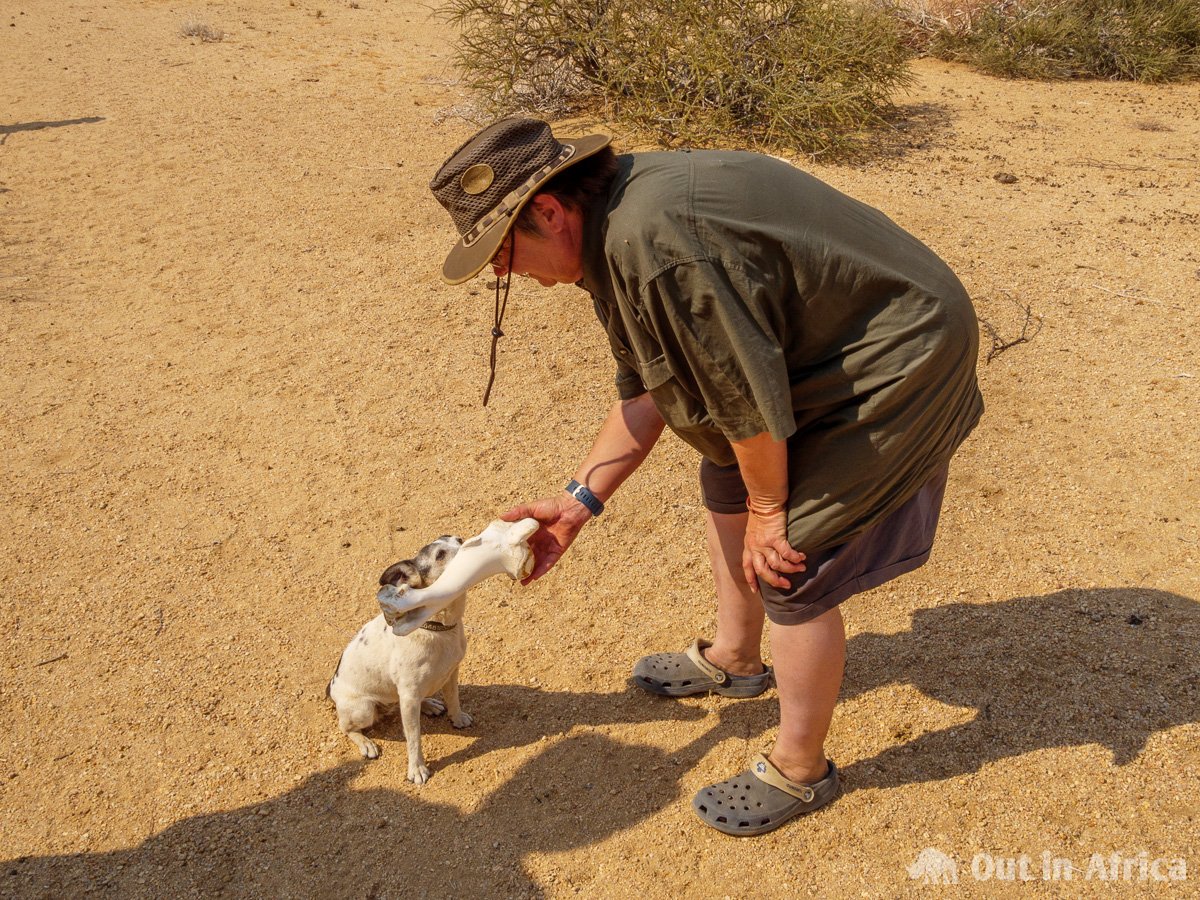
Transport Container
We have an IATA approved bag for dogs. It’s big enough; Penny can stand upright in it. The sides are made of nylon or mesh fabric. That way she can move a bit and sleep well. We have lined the bag with a light blanket.
If your dog has to travel in the cargo area, you will need a hard plastic box. It is important that the dog can be supplied with water in the box.
Other Accessories
Collar and dog leash is already present. We take both a normal dog leash and a retractable leash with us. We use the latter if the dog should have more freedom of movement during the walk.
On the collar, we have a weatherproof badge with the name of the dog and a Namibian phone number. These small waterproof capsules, which you can hang on your collar and in which you can put a note with the name and phone number, do not work with Penny. After a few hours, only the lid of the capsule hangs on the leash. Of course, it doesn’t have to be a Namibian phone number, but a local number is more likely to be called if the dog is found than with a European number. If you don’t have a Namibian number, but you’re going to get a SIM card anyway, we recommend Rogz name tags. You can label them as soon as you have your phone number. Also, you can have a metallic name tag engraved in many pet shops.
We always take a water bowl for the dog with us.
Since we travel regularly to Namibia and have a place where we can store our equipment, we have accumulated a lot of stuff for the dog. We have a fabric dog basket, more bowls and toys ready when we land in Namibia.
Food
Dog food can be bought in any supermarket and of course in pet shops. So, all you have to do is take along the food the dog needs during the journey.
The Flight
I will now describe a typical flight with Penny, as we have done many times before.
Fasting
The most important thing in the life of Penny is by no means her two mistresses. The most important thing is food. It’s sad for us, but it’s true.
Eating and drinking also mean that a few hours later the dog has to go for a walk. You can’t do that 11,000 meters above the earth’s surface in an aeroplane. Especially not if the dog has to stay in his bag.
Before anyone accuses us of cruelty to animals, I will give a few facts about the physiology of dogs:
A healthy adult dog can easily live 25 days without a meal. Without a sip of water, however, he would be dehydrated after six to seven days. The physiology of dogs, whether wild or domestic, is geared toward irregular nutrition. In the wild, the big catch is not on the menu every day.
Source: https://www.planet-wissen.de/natur/haustiere/hunde/pwiewissensfragen102.html#Ohne_Nahrung
Penny gets nothing to eat from 24 hours before departure and nothing to drink from 12 hours before departure. That sounds hard, but it works, and she survived the many trips to Namibia without any problems. Since she’s a dog who drinks very little anyway, it’s not that bad for her not to drink. However, she thinks it’s ridiculous that she doesn’t get anything to eat, but we stay tough.
Since she is not allowed to weigh more than six kilos, she has been on a diet for weeks before the flight. Usually, she weighs between 5.6 and 5.8 kilos.
Most of the time the flight is in the evening. During the day departure, she gets a lot of exercise. She may not sleep as much as usual. Thus, she is so tired during the flight that she easily sleeps through the 10 hours without having to be given a sedative.
Our veterinarian has warned us against using sedatives, as a dog can cool down more quickly in a dozy state than if it was just sleeping
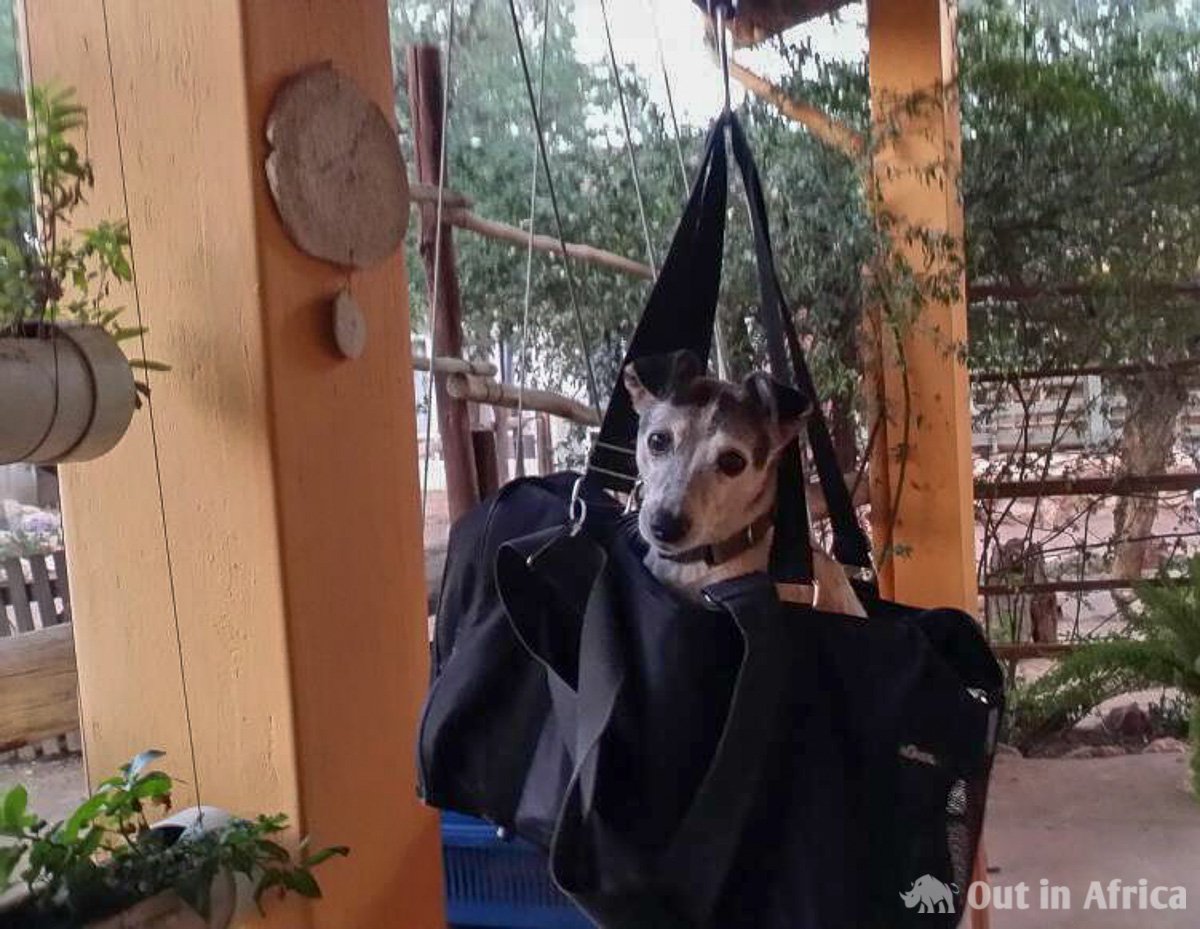
Check-In
We check in our baggage two to three hours before departure. The check-in staff will check whether there is a ticket for the dog. Usually, they weigh the dog with the flight bag. Therefore, it makes sense to put everything that makes the bag unnecessarily heavy into your hand luggage beforehand. If dog and bag weigh a little more than six kilos, it’s no big deal. The ground crew takes a look at the dog and the bag and decides whether everything is in order. Sometimes the dog is not weighed at all but only viewed. “You don’t ask a lady about her weight.” they once said.
That’s been our experience so far. But we have also heard about travellers who were forced to buy another flight bag at the airport because it was said not to be the right size. If the dog is much heavier than allowed, you may have to get a cargo box, and the dog has to fly in the cargo area. However, we have not yet experienced this personally.
Before boarding
When the luggage has been checked in, the dog is taken for a walk again. We now know all the lawns at Frankfurt a.M., Munich and Cologne airports. Once you’ve passed the safety check, it’s no longer possible to go for a walk until you land in Windhoek.
We always lay out the bag with a diaper in case something happens, and of course, we have dog waste bags and paper towels with us.
While we wait for the boarding, the dog is being kept awake. When we are called to board, we open the dog bag, and it is finally allowed to go into the bag. Penny is then so happy that she is allowed to sleep, that she voluntarily lies down in her bag without grumbling and sleeps for the next ten hours.
During the flight
Then there’s the problem with the space on the plane. I’ve already said that you have to buy an additional ticket for the dog, but the dog doesn’t get an extra seat. If we’re lucky, there’s an empty seat next to us. If not, we try to get two free seats next to each other as soon as boarding is completed. Then the dog can travel on its seat. If you have a lot of bad luck, it’s not possible to get an empty seat for the dog and then it gets very cramped during the flight.
During take-off and landing, the flight bag must be on the ground. During the flight itself, the bag may be on the mistress’s lap or an empty seat alongside.
During the flight, the dog must remain in the bag.
Penny is a very quiet dog. It often happens that the crew only notices that a dog was with them when we get out of the plane. Of course, you can practice this beforehand with your dog.
One hour before the landing she is gently woken up and gets (inconspicuously) a little water and dry food. But she remains quietly in her bag. Usually, she stretches a little and then lies down again.
After the flight
Arrival
After arriving in Windhoek, you walk from the plane to the airport building. A large number of airport staff are present to ensure that arriving passengers follow the prescribed route. As soon as we are away from the parking lot for the plane and arrive at the building, we ask the staff if the dog may get out of the bag. Until now, they always allowed this. Then she can pee immediately, but of course, we make sure that she doesn’t do so on the sidewalk itself but at a tree.
For the immigration procedure, she has to go back into her bag because the crowd in front of the counters is very large. While we wait for the luggage, she is allowed out and gets some water and some food again.
Then we take the luggage through customs, where we present all documents for the import of the dog. We don’t even try to go through the green door at the customs check at the airport, but go to customs and show all forms and the pet passport. No one reads through the form, and everyone is impressed by the passport and waves us through without further ado. And then you finally arrived.
At the airport in Windhoek, there are lawns that one should visit before continuing one’s journey.
Veterinary Office Namibia
Sometimes a veterinarian is at the airport and receives the stamped documents. Then you don’t have to go to the vet anymore. If no veterinarian is present, you have to go to the office in Windhoek. I have already said that the veterinary office in Windhoek is one of the most efficient authorities in Namibia. You go there with the dog and say that you have just arrived with the animal and show all the papers. They will stamp the documents, and then the dog will have officially entered the country.
Shopping
You don’t need to take any food with you except what the dog eats during and shortly after the flight.
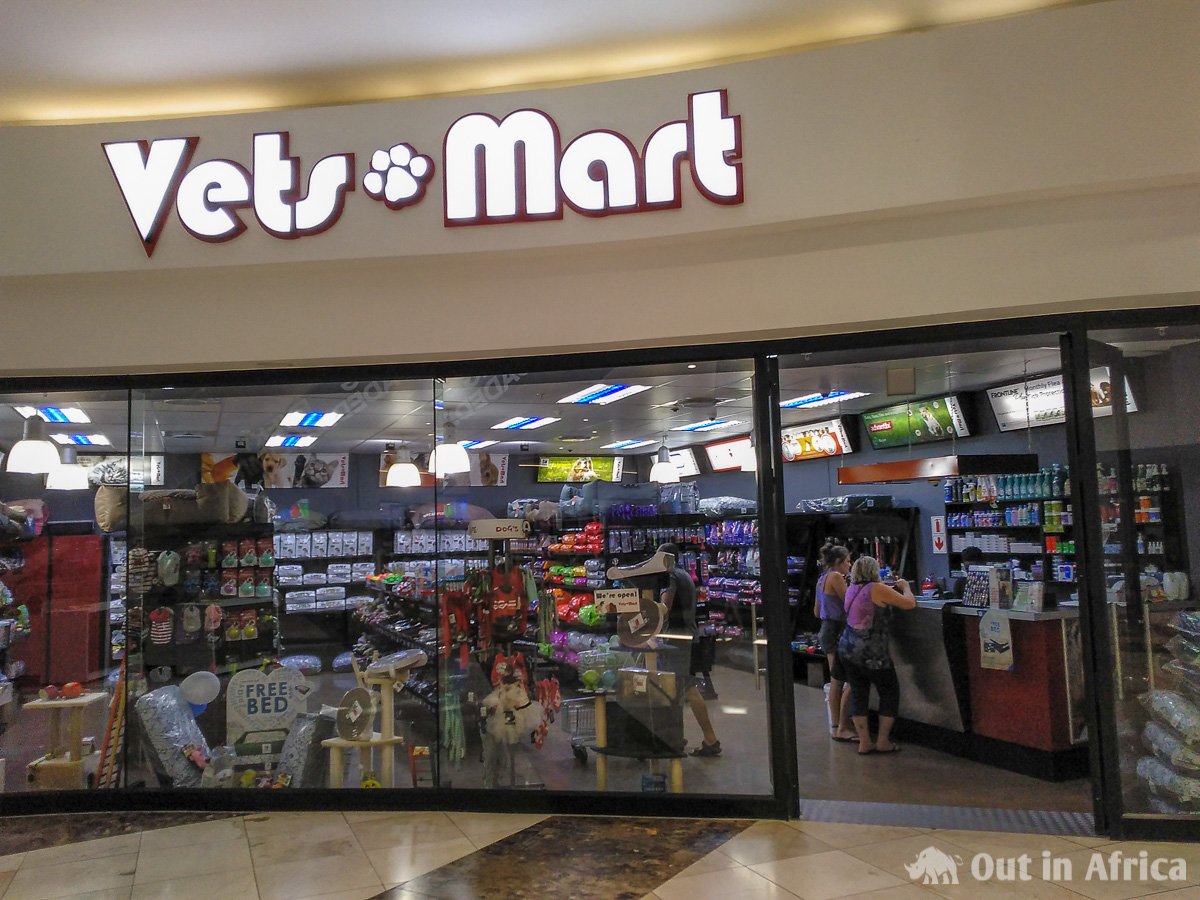
In Namibia, even the smaller supermarkets have dog food. Both dry and wet food is available. We always buy a bag of dry food because
- Penny is accustomed to it also from home
- It is easier and cleaner to transport
There are also special shops for pets, where you can also buy well-known brands from Germany. You can also buy dog leashes, dog blankets, food bowls and toys in almost every supermarket.
Penny loves to wallow in carrion. If your dog has the same unpleasant quirk, get some dog shampoo.
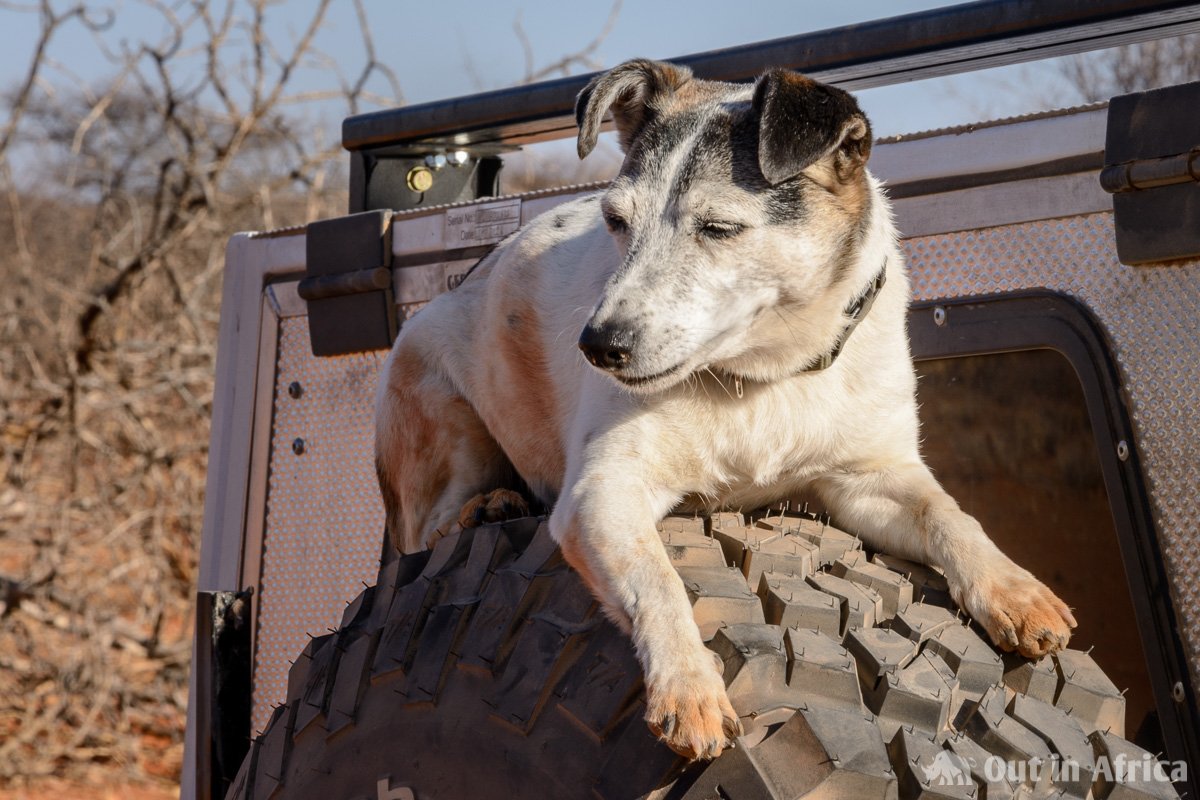
Veterinarians
Penny’s had to see a vet a couple of times in Namibia. Once she a cheeky mongoose (my brother’s pet) bit her, once she had her eyebrow ripped up on a wire, and during our last stay, a neighbour’s dog bit her. Of all three events, the last one was the most serious, as she was in great shock and in danger of losing her eye. All events took place in Windhoek and so veterinary help was not far away.
In principle, the veterinarians are comparable to those in Europe regarding training, knowledge and skills. But they can also deal with events that do not occur in Germany like snake and baboon bites. Penny has never experienced anything like it, but it’s happened before to dogs in the family. The dogs have always survived, but also because it was never far to the next vet.
We have health insurance for the dog that covers surgery. In the case of injuries where the wound had to be sutured, the costs were paid by the insurance company.
When I plan a trip, I also look for the addresses and phone numbers of veterinarians and save them as waypoints in the navigation system. There are veterinarians in every small town in Namibia. The waypoints make it easy to identify and approach the nearest veterinarian in an emergency.
If needed, many farmers can also provide first aid, as they often deal with sick or injured animals.
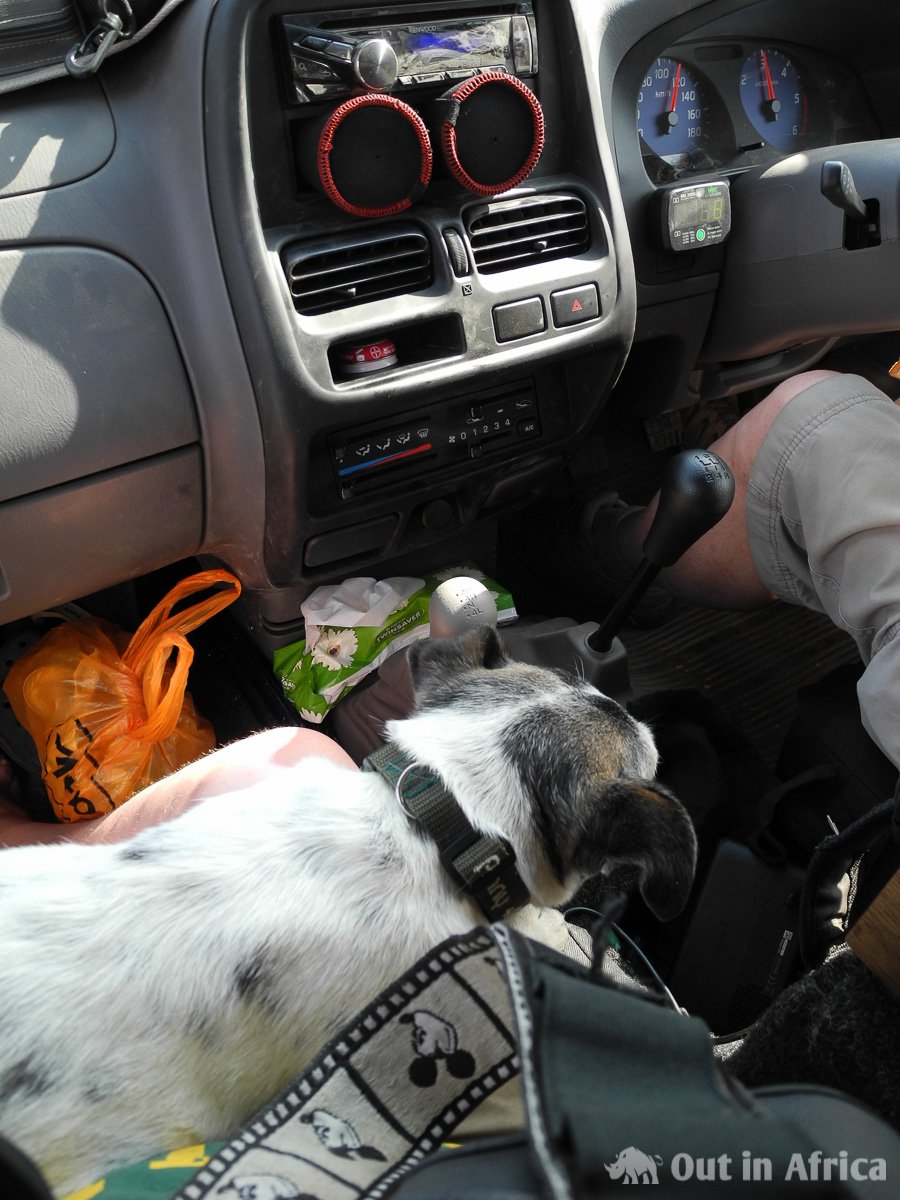
rules of conduct
It should be self-evident, but I want to mention it anyway:
- Don’t bother other people with your dog’s poo. Put it away. Doing so is the only way to maintain the goodwill of lodges, guest farms and campsites that allow dogs.
- Other guests also come because of the tranquillity. One should, therefore, make sure that they are not bothered by the barking of the dogs.
- Penny is a Jack Russell Terrier, i.e. she is a hunting dog. Because of this, we tie her to a long rope on a campsite so that she doesn’t even quickly go into the field and hunt any animals. Since she also likes to swim, we have to tie her up on campsites along the northern rivers so that she doesn’t go into the water and become a victim of crocodiles or hippos. Therefore, we also recommend you to get a long rope with a carabiner so that your dog stays with the campsite.
- We already mentioned it: the most important thing in the life of Penny is food. Unfortunately, other campers are often inattentive and leave food standing open. That’s why we always make sure Penny doesn’t steal anything there.
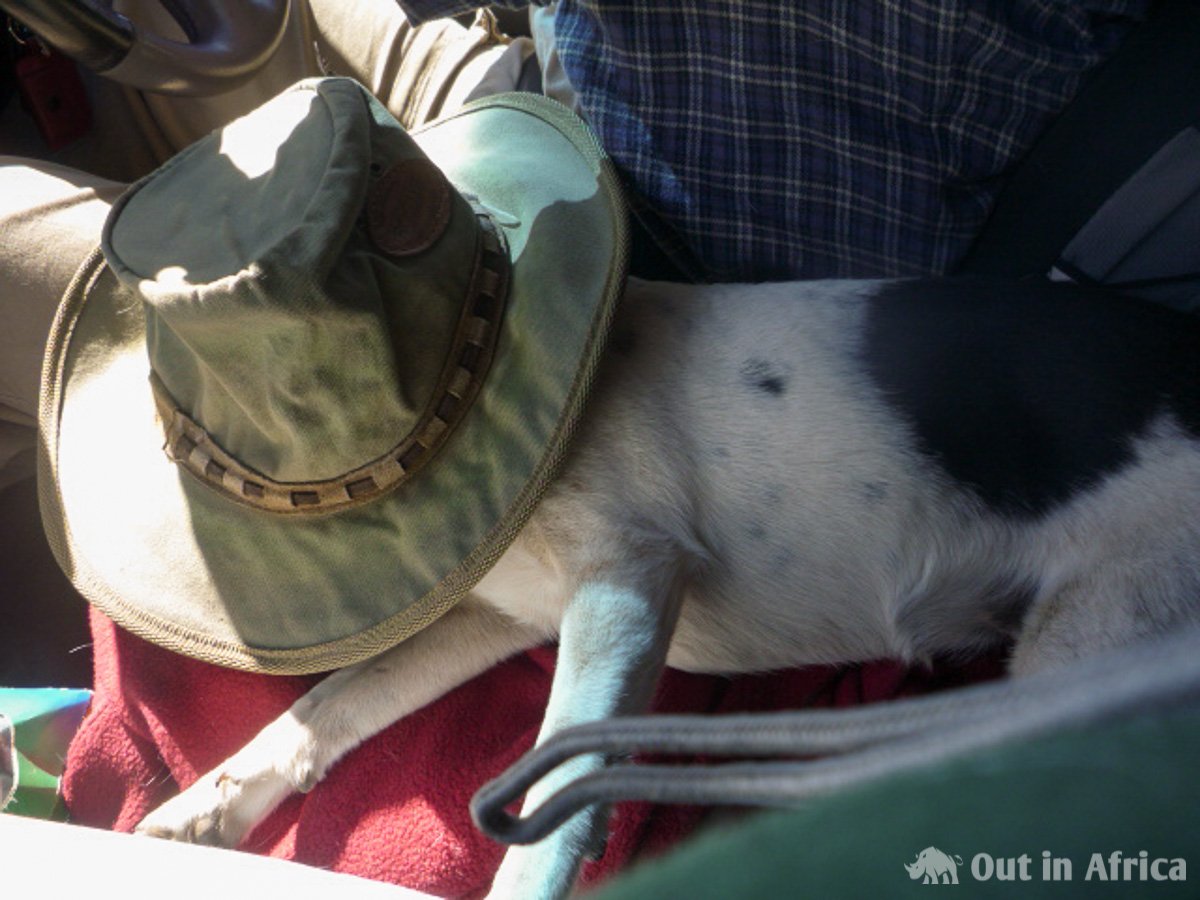
Travelling to other SADC countries
It is easy to travel with an animal from Namibia to South Africa or another SADC country by car. All you need to do is get the appropriate permit from a veterinary office in Namibia. It is possible that for the return journey to Namibia one needs a permit of the veterinary office of the other state again. For one or two weeks in the other state, it is not necessary, for several months it might be. Check in advance at the border control if and when a further import permit is required.
Not all border crossings allow entry and exit with dogs. Last year, for example, we were stuck in Onseepkans. The South African border guard was very helpful but did not let us cross over to Namibia with two dogs, because there was no one on the Namibian side to control the import of animals. We had to travel either via Nakop/Ariamsvlei or Vioolsdrift/Noordoewer. We decided to go with Noordoewer and could enter Namibia without any problems. But the papers of the dogs were checked.
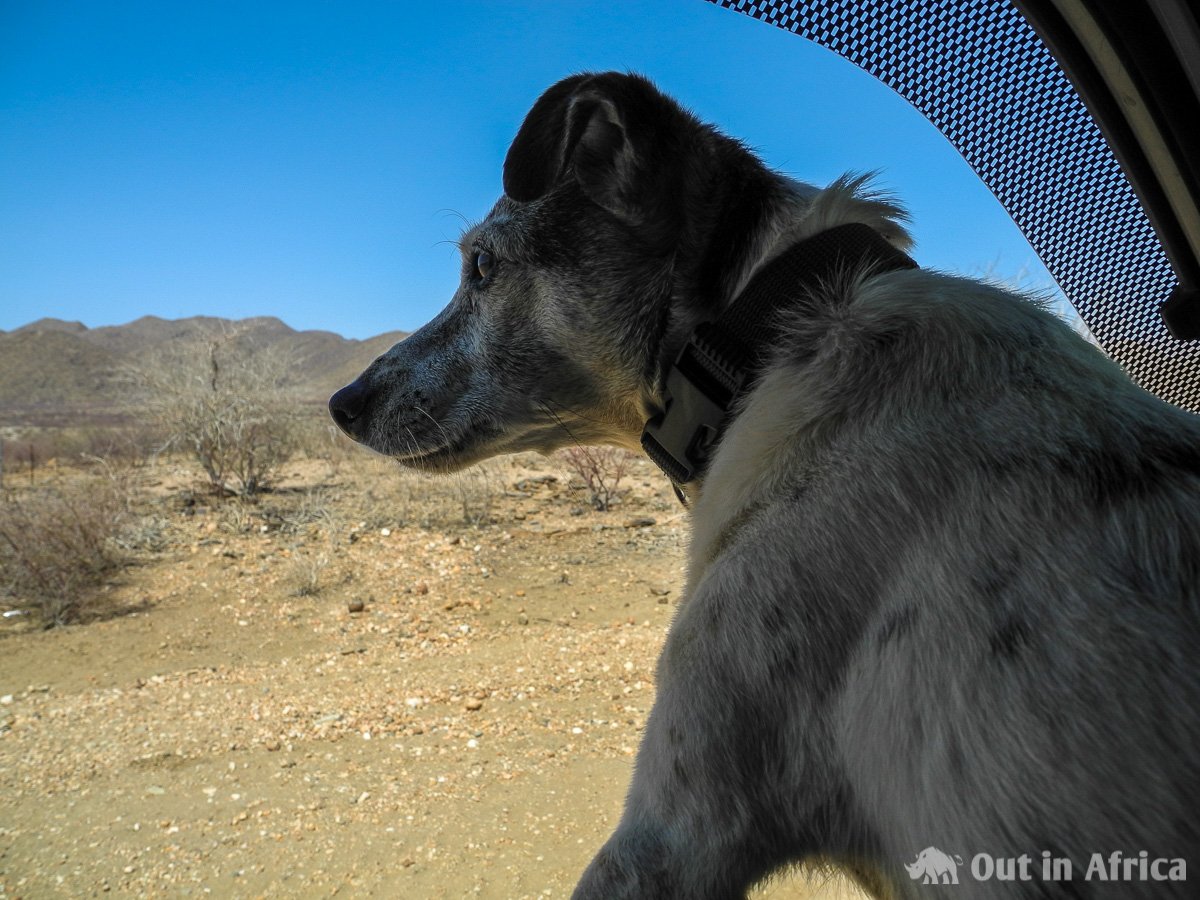
Checklist
- Has the dog been vaccinated regularly, especially against rabies, and are these vaccinations always up-to-date?
- Is the rabies titre correct, i.e. is there a positive blood test for rabies antibodies?
- Is the dog chipped?
- Does the dog have a European pet passport?
- Did you book the flight for the dog?
- Have you applied for an import permit for the dog at the veterinary office in Namibia?
- Have you received the Veterinary import permit for animals?
- At least 30 days before the flight: How will the official veterinarian respond to the question of whether diseases occur in the country?
- No more than three days before the flight – Visit of the official veterinarian
- Preparation of the dog bag:
○ dog excrement bag
○ Diaper
○ Paper towels
○ (Fleece) blanket
○ water bowl
- 24 hours before departure: the dog doesn’t get anything to eat any more
- 12 hours before the departure: the dog gets nothing to drink any more
- 3 hours before departure: check-in with dog
- Afterwards: go for a walk again!
- Boarding: the dog goes into the flight bag
- Flight
- One hour before landing: Wake dog up, give something to drink and eat
- Landing
- If you can: go for a walk before entering the country
- Entry and Customs
- Visit the veterinary office in Windhoek
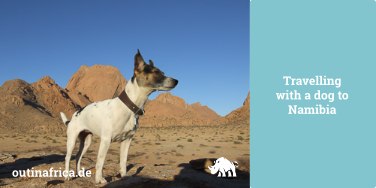
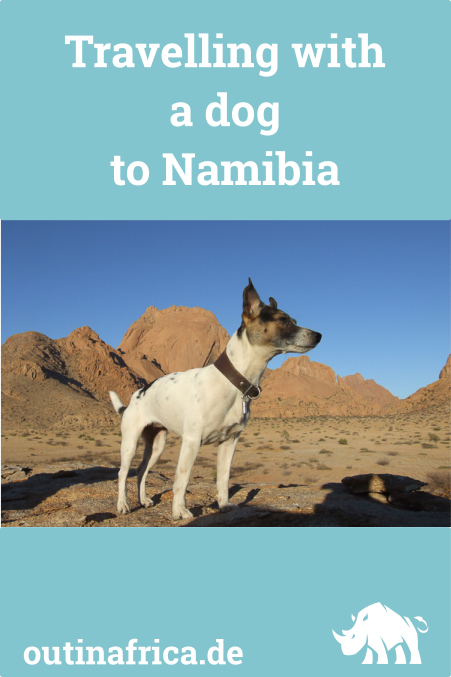

Hi. I would like to know if I can call you to ask some questions about taking a dog to Namibia. I would really appreciate it